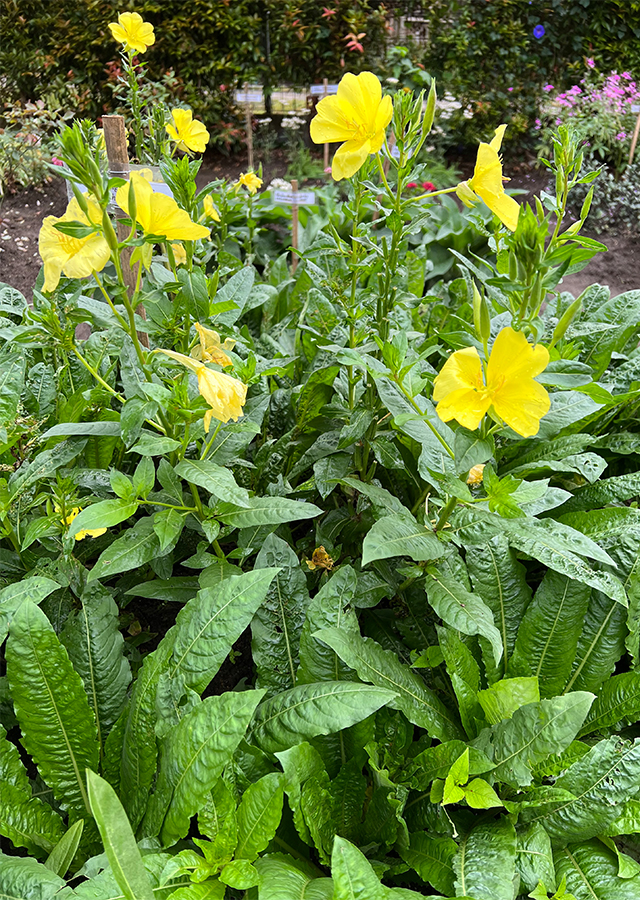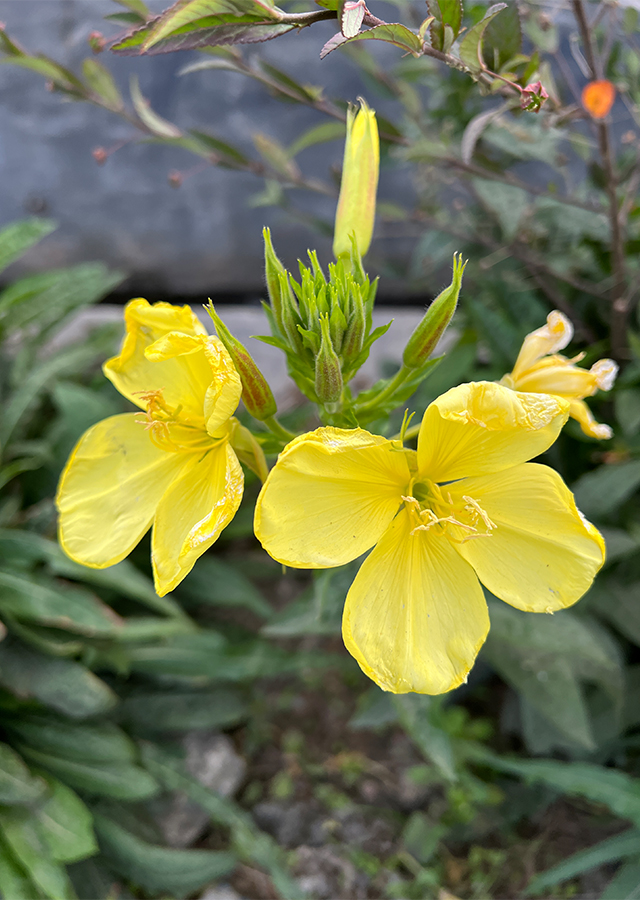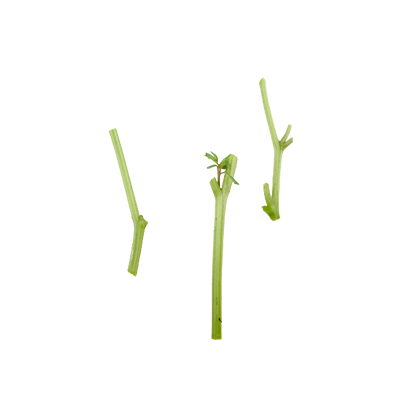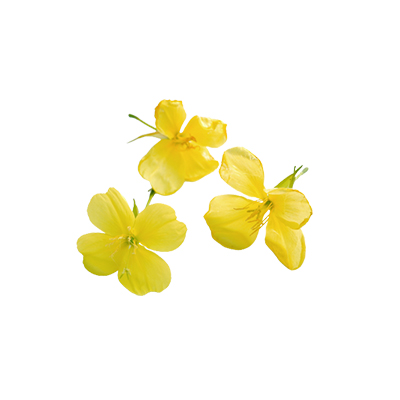Common Evening Primrose
Oenothera biennis L.
Onagraceae
Location in our garden
Principal



Synonym
Brunyera biennis Bubani
Oenothera beckeri Renner
Onagra biennis (L.) Scop.
Habitus
Herbaceous. An upright biennial, growing up to 1.20 m tall.
Part Used
Leaves
Flowers
Roots
Stem
Growing Requirements
Full Sunshine
Drought Resistant
Habitat
Roadside
Terrestrial
Overview
Oenothera biennis is native to eastern and central North America. It is used as a medicine, has environmental uses, for food and source of materials. All parts of this plant including the roots were once used as food by American Indians. Formerly cultivated for its edible roots, the evening primrose is being increasingly cultivated for the oil contained in its seed which contains certain essential fatty acids and is a very valuable addition to the diet, added to skin preparations and cosmetics. Evening primrose oil has become a well-known food supplement since the 1980's. A yellow dye is obtained from the flowers. A finely ground powder made from the flowering stems is used cosmetically in face-masks to counteract reddened skins.
Vernacular Names
Hierba del asno (Spanish), Onagre bisannuelle (French), Gemeine Nachtkerze (German), Enagra )Italian), Arechimatsuyoigusa (Japanese), Canarias (Brazil), Nattljus (Swaziland).
Agroecology
Commonly grows in fields, prairies, glades, thickets, waste ground, disturbed sites, and along roadsides and railroad right-of-ways. Easily grown in average, medium moisture, well-drained soils in full sun. Tolerates some part afternoon shade and some drought. Grows well in gravelly or sandy soils.
Morphology
- Roots - stout taproot.
- Stem - hairy, green (sometimes reddish).
- Leaves - in basal rosette and alternate on stem. Rosette leaves long-stalked, wither during flowering time, stem leaves short-stalked. Rosette leaves’ blade ovate–narrowly elliptic, stem leaves’ blade elliptic–narrowly ovate, small-toothed–with entire margins.
- Flower - open in the evening and are strongly scented with a delicious sweet perfume. Corolla regular (actinomorphic), yellow (sometimes reddish), approx. 2–3 cm long; petals four, 25–30 mm long. Sepals 4, narrowly triangular, recurved. Stamens 8. Pistil formed from two fused carpels, stigma 4-lobed. Inflorescence a spiked raceme.
- Fruit - capsules (narrow seed pods to 3.8 cm long) which split open when ripe to release numerous seeds (to 100 seeds per capsule).
- Seed - capsules, or pods, are thicker at their base then at the top. These are stiff and hard, composed of 4 chambers (valves) and contain 300 to 400 very small reddish brown seeds per capsule.
Cultivation
Generatively propagated by seed - sow in situ from late spring to early summer.
Chemical Constituents
Flavonoid glycosides (kaempferol-3-O-glucoside, quercetin-3-O-galactoside, quercetin-3-O-rhamnoside, myricetin-3-O-glucoside), tannins (oenothein A, oenothein B), linolic, gamma-linolenic acid, fatty acids (oleate, palmitate, stearic acid), phenolic compounds (gallic acid, caffeic acid, epicatechin, coumaric acid, ferulic acid, rutin and rosmarinic acid), sterols (sitosterol, oenothera lanosterol A, oenothera lanosterol).
Traditional Medicinal Uses
- The leaves are astringent and sedative, and used in the treatment of gastro-intestinal disorders of a functional origin, whooping cough and asthma.
- A syrup made from the flowers is also an effective treatment for whooping cough.
- The oil is potentially very valuable in the treatment of multiple sclerosis, pre-menstrual tension, hyperactivity etc It is also taken internally in the treatment of eczema, acne, brittle nails, rheumatoid arthritis and alcohol-related liver damage, helps to reduce blood cholesterol levels and lower the blood pressure.
- The poulticed root is applied to piles and bruises.
- A tea made from the roots is used in the treatment of obesity and bowel pains.
Part Used
Reference Sources
- Bebeau, G.D. (2014). Plants of the Eloise Butler Wildflower Garden: Common Evening Primrose. https://www.friendsofthewildflowergarden.org/pages/plants/eveningprimrose.html#:~:text=Seeds%20of%20Common%20Evening%20Primrose,reddish%20brown%20seeds%20per%20capsule. 15-04-2022.
- CAB International. (2022). Invasive Species Compendium: Oenothera biennis (common evening primrose). https://www.cabi.org/isc/datasheet/115863. 15-04-2022.
- Fecker R. et al. (2020). Phytochemical and Biological Screening of Oenothera biennis L. Hydroalcoholic Extract. Biomolecules, 10, 818, doi:10.3390/biom10060818.
- Fern, Ken. (2021). Useful Temperate Plants: Oenothera biennis. http://temperate.theferns.info/plant/Oenothera+biennis. 15-04-2022.
- Missouri Botanical Garden. (No date). Oenothera biennis. https://www.missouribotanicalgarden.org/PlantFinder/PlantFinderDetails.aspx?taxonid=283027#:~:text=Oenothera%20biennis%2C%20commonly%20known%20as,%2C%20Utah%2C%20Colorado%20and%20Arizona. 15-04-2022.
- Nature Gate. (2021). Evening Primrose. https://luontoportti.com/en/t/2189/evening-primrose. 15-04-2022.



